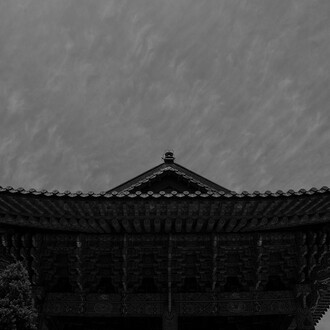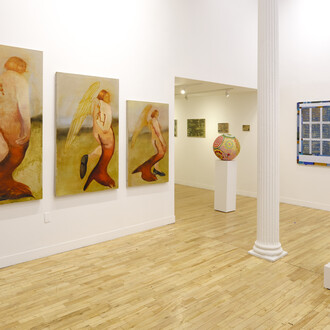As an artist, Kim Gyoung Min favors highly accessible works of Korean people doing everyday things—riding bicycles, sitting on benches, reading a book. Her figures, elongated and thin, make extravagant gestures and offer idiosyncratic facial expressions, usually in the form of an exaggerated smile. Kim is very much aware that her idiom, which she extends not only to indoor sculptures but also to public works commissioned for city halls, parks, and subway stations, is extremely approachable both to the art milieu she belongs to and to everyday people taken by her colorfully clothed, slightly eccentric figures. The people she portrays are not specific individuals, but rather characters found in regular life. Their context may be unusual—the book reader sits on a high branch of a tree reading—and so Kim’s willingness to present an idiosyncratic, stylized view of people engaged in regular activities, such as listening to a cell phone or taking a bath, allows her to comment on the way life is usually lived in South Korea.
This does not mean that the figures are bounded by East Asian culture. Although their faces are Asian, the sculptures participate in activities known throughout the world—actions familiar to most of us, anywhere, who live in a contemporary mercantile culture. Kim thus celebrates the ordinariness of life, making it more than slightly amusing as she constructs acrylic on bronze works whose familiarity of gesture joins the art to the perception of anyone caring to look it over. Everyone immediately understands Kim’s pieces, which ask only that we glance at them and smile.
Kim’s choice to work figuratively, in terms that are as available for the artistically uneducated as for the sophisticated viewer, enables to reach most everyone. Because we are living in a time of populism in art, sometimes politically driven and sometimes not, we experience her caricatures with only a bit of dissonance. As has been suggested, it is possible to see these figures as a critique of the good life. But that is most likely not the case. Instead, Kim is offering us a vision of simple pleasures, based on material goods available to us now. One might argue, with the insight, finding that the figures seem self-contained, surrounded by a self-serving bliss only they are taking part in. At the same time, because the activities they are engaged in are as simple as they are, this self-absorption is available to everyone. In South Korea’s mercantile democracy, a premium is placed on private satisfaction, fueled by the ubiquity of things. Thus, Kim illustrates a particular kind of happiness, in which anxiety is forbidden and the pleasure of the moment embraced. There is nothing to judge, nothing even to experience except the ecstasy of a simple life. While the artist’s works offer caricature and idiosyncrasy, that does not mean that her sculptures are condemning the life they portray. Instead, they offer a brave new world, in which gratification of the moment holds sway.
By Art Critic Jonathan Goodman
















